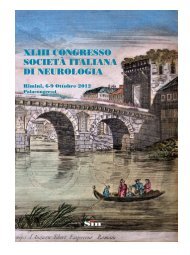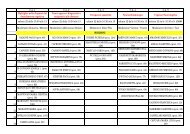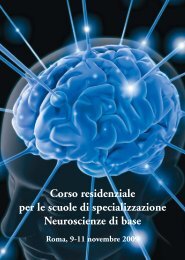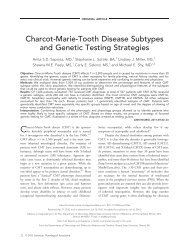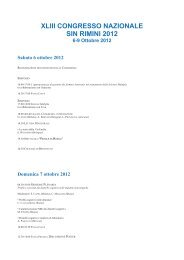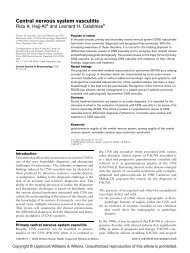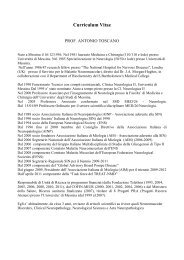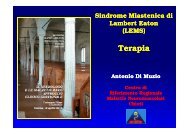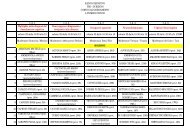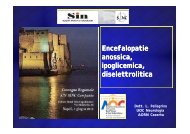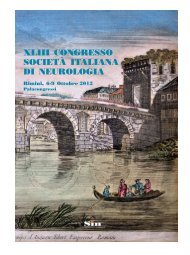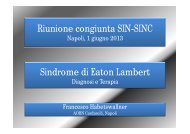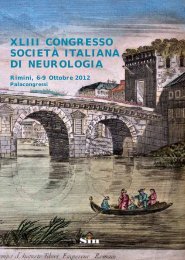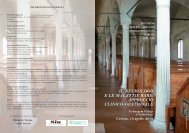Glucose transporter-1 deficiency syndrome: the expanding clinical ...
Glucose transporter-1 deficiency syndrome: the expanding clinical ...
Glucose transporter-1 deficiency syndrome: the expanding clinical ...
- No tags were found...
Create successful ePaper yourself
Turn your PDF publications into a flip-book with our unique Google optimized e-Paper software.
Clinical and genetic spectrum of GLUT1DS Brain 2010: 133; 655–670 | 657Introduction<strong>Glucose</strong> <strong>transporter</strong>-1 (GLUT1) <strong>deficiency</strong> <strong>syndrome</strong> (OMIM#606777) is an autosomal dominant haplo-insufficiency disorder,leading to a reduced glucose transport into <strong>the</strong> brain (Seidneret al., 1998). GLUT1 is highly expressed in <strong>the</strong> endo<strong>the</strong>lial cellsof erythrocytes and <strong>the</strong> blood-brain barrier and is exclusivelyresponsible for glucose transport into <strong>the</strong> brain (Vannucci et al.,1997; Barros et al., 2007). GLUT1 <strong>deficiency</strong> <strong>syndrome</strong> was firstdescribed in 1991 by De Vivo et al. (1991). The classic patientwith GLUT1 <strong>deficiency</strong> <strong>syndrome</strong> presents with infantiledrug-resistant seizures, mild to severe developmental delay andan acquired microcephaly in up to 50% of <strong>the</strong> cases. Hypotonia,spasticity, ataxia and dystonia are elements of a complex movementdisorder (Klepper and Leiendecker, 2007). In recent years,however, is has become apparent that <strong>the</strong> <strong>clinical</strong> spectrum ofGLUT1 <strong>deficiency</strong> <strong>syndrome</strong> is much broader (Brockmann,2009). Patients with a non-classical phenotype featuring developmentaldelay and movement disorders without epilepsy have beendescribed (Overweg-Plandsoen et al., 2003; Hennecke et al.,2005; Friedman et al., 2006; Klepper et al., 2007), as well asfamilial and sporadic paroxysmal exercise induced dyskinesiawith or without epilepsy (Suls et al., 2008; Weber et al., 2008;Schneider et al., 2009).When GLUT1 <strong>deficiency</strong> <strong>syndrome</strong> is suspected on <strong>clinical</strong>grounds, a lumbar puncture in <strong>the</strong> fasting state should be performed.GLUT1 <strong>deficiency</strong> <strong>syndrome</strong> is characterized by a lowglucose concentration in <strong>the</strong> cerebrospinal fluid (hypoglycorrhachia)in <strong>the</strong> absence of hypoglycaemia, in combination with alow to normal lactate in <strong>the</strong> cerebrospinal fluid (Klepper et al.,1999b; Klepper and Voit, 2002). It is important to recognizeGLUT1 <strong>deficiency</strong> <strong>syndrome</strong>, since <strong>the</strong> disorder can be treatedwith a ketogenic diet. Ketone bodies use ano<strong>the</strong>r <strong>transporter</strong> toenter <strong>the</strong> central nervous system and thus can supply <strong>the</strong> brainwith an alternative fuel.In most patients <strong>the</strong> ketogenic diet markedly reduces <strong>the</strong> frequencyof seizures (Klepper et al., 2005) and <strong>the</strong> severity of <strong>the</strong>movement disorder (Brockmann, 2009). Behaviour and alertnessalso frequently improve (Klepper et al., 2005, 2007; Joshi et al.,2008).For <strong>the</strong> diagnosis of GLUT1 <strong>deficiency</strong> <strong>syndrome</strong>, GLUT1 westernblot analysis in erythrocyte membranes and glucose uptakeinto erythrocytes can be applied to determine GLUT1 function.Negative western blots or erythrocyte uptake studies, however,do not rule out <strong>the</strong> diagnosis (Klepper et al., 1999a). GLUT1 <strong>deficiency</strong><strong>syndrome</strong> can be confirmed by mutation analysis of <strong>the</strong>SLC2A1 gene. The SLC2A1 gene, mapped to <strong>the</strong> short arm ofchromosome 1 (1p35-31.3) (Shows et al., 1987), is a relativelysmall gene and consists of ten exons, spanning 2842 base pairsencoding 493 amino acids (Fukumoto et al., 1988).The structure and function of <strong>the</strong> GLUT1 protein has beenintensively investigated (Hruz and Mueckler, 2001). Theamino-acid sequence of <strong>the</strong> GLUT1 protein is highly conserved,with 97–98% identity between <strong>the</strong> human, rat, rabbit, mouseand pig sequences, which implies that all domains of this proteinare functionally important (Baldwin, 1993). GLUT1 has12 transmembrane alpha-helices (Mueckler et al., 1985), separatedby a large intracellular loop between helices 6 and 7. A 3D modelfor GLUT1 has been proposed, predicting a central aqueouschannel communicating <strong>the</strong> extracellular and intracellular compartments,with many residues crucial for glucose transport locatedaround this central channel (Mueckler and Makepeace, 2009).Since <strong>the</strong> first description of GLUT1 <strong>deficiency</strong> <strong>syndrome</strong> and<strong>the</strong> elucidation of its genetic cause, a wide spectrum of around 60different mutations in <strong>the</strong> SLC2A1 gene has been described inapproximately 100 patients (Wang et al., 2005; Klepper andLeiendecker, 2007), including large-scale deletions, missense, nonsense,frame shift and splice-site mutations. All mutations ei<strong>the</strong>rlead to absence or loss of function of one of <strong>the</strong> SLC2A1 alleles.Several hot spots for recurrent mutations have been identified(Asn34, Gly91, Ser113, Arg126, Arg153, Arg264, Thr295,Arg333) (Klepper and Leiendecker, 2007). Thus far, correlationsbetween phenotype and genotype remained elusive (Wang et al.,2005; Brockmann, 2009). Here we report on <strong>the</strong> genetic, biochemicaland <strong>clinical</strong> characteristics of 57 newly diagnosed patientswith GLUT1 <strong>deficiency</strong> <strong>syndrome</strong>.Materials and methodsPatientsFrom January 2004 to July 2008 <strong>the</strong> DNA Diagnostics Laboratory(Department of Human Genetics of <strong>the</strong> Radboud UniversityNijmegen Medical Centre, The Ne<strong>the</strong>rlands) received 132 requestsfor mutational analysis of <strong>the</strong> SLC2A1 gene in patients suspected tohave GLUT1 <strong>deficiency</strong> <strong>syndrome</strong> from all over <strong>the</strong> world (excluding<strong>the</strong> requests for carrier testing in parents and o<strong>the</strong>r family members ofaffected patients). In 54 patients (41%) suspicion of GLUT1 <strong>deficiency</strong><strong>syndrome</strong> was confirmed by <strong>the</strong> identification of a pathogenic mutationin <strong>the</strong> SLC2A1 gene. Additionally, we identified a mutation in <strong>the</strong>SLC2A1 gene in three <strong>clinical</strong>ly affected family members, bringing <strong>the</strong>total number of patients with GLUT1 <strong>deficiency</strong> <strong>syndrome</strong> confirmedby mutation analysis to 57. Clinical data were retrospectively collectedfrom referring physicians by means of a written, detailed questionnaire.Results were reviewed against <strong>the</strong> background of <strong>the</strong> existingliterature on SLC2A1 gene mutations and associated phenotypes.Mutation analysisGenomic DNA was extracted from blood samples by standard procedures.Automated Sanger sequencing was performed to study <strong>the</strong>entire coding sequence including at least 20 base pairs of intronicsequence flanking each exon of <strong>the</strong> SLC2A1 gene. Polymerase chainreaction (PCR) amplification of all 10 exons of <strong>the</strong> SLC2A1 gene wasperformed using Fast PCR Master Mix (Applied Biosystems, FosterCity, California, USA). Primer sequences are available upon request.Sequencing reactions were carried out using BigDye V. 3.1 (AppliedBiosystems) and analysed on an ABI 3730 capillary sequencer (AppliedBiosystems). Sequences were compared to <strong>the</strong> wild-type sequence assubmitted to Genbank (Genbank Accession Number NM_006516). Allpreviously unreported mutations were verified in a panel of at least100 control alleles. The reference sequence was used in which <strong>the</strong> A of<strong>the</strong> ATG start-codon is designated position 1. Amino-acid residueswere numbered from <strong>the</strong> first methionine residue; according to <strong>the</strong>protein accession number NP_006507.Downloaded from http://brain.oxfordjournals.org at centro sperimentale di medicina e biotecnologie-cnr on August 5, 2010



